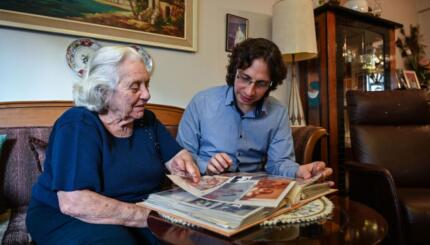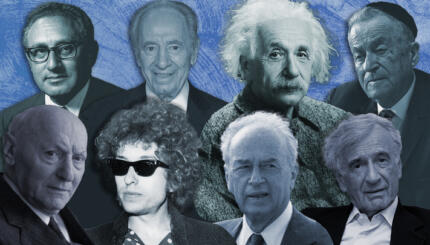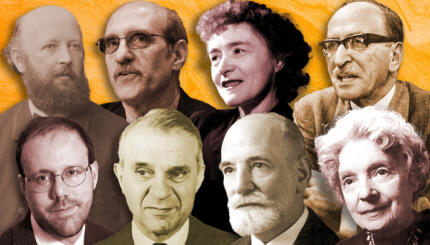In 1966, the eminent art critic Harold Rosenberg addressed an audience at the New York Jewish Museum and reflected on the nature of Jewish art.
“Is there a Jewish art?” he began. “First they build a Jewish Museum, then they ask, Is there a Jewish art? Jews!”
The good ole’ Jewish humor belies the radical shift that was unfolding at precisely the time and place that Rosenberg spoke. Modern Jewish art had quietly taken shape in America over the prior two decades. But now, in the mid-1960s, just as Rosenberg would finally pronounce its name, modern Jewish art would become something else entirely.
Action Painters
What did modern Jewish art mean to Rosenberg, the man who championed Mark Rothko, Barnett Newman, and the other American Action Painters (to use Rosenberg’s term; today we call them Abstract Expressionists)? The final paragraphs of Rosenberg’s talk proclaimed the newfound dominance of American art and also gave voice to an American-Jewish dream dominant at mid-century:
With your help, My Jewish Learning can provide endless opportunities for learning, connection and discovery.
“Artists like Rothko, Newman, Gottlieb, Nevelson, Guston, Lassaw, Rivers, Steinberg and many others helped to inaugurate a genuine American art by creating as individuals.”
Amazingly, all of these artists were Jewish. So why did Rosenberg call their work a genuine American art? Why not Jewish art?
“This work, inspired by the will to identity, has constituted a new art by Jews which, though not a Jewish art, is a profound Jewish expression, at the same time that it is loaded with meaning for all people of this era.”
If it’s not a Jewish art, what makes it a profound Jewish expression?
“In the chaos of the 20th century, the metaphysical theme of identity has entered into art, and most strongly since the war. It is from this point that the activity of Jewish artists has risen to a new level…American Jewish artists, together with artists of other immigrant backgrounds–Dutchmen, Armenians, Italians, Greeks–began to assert their individual relation to art in an independent and personal way.”

Concord, 1949
Barnett Newman (American, 1905–1970)
Oil and masking tape on canvas; 89 3/4 x 53 5/8 in. (228 x 136.2 cm)
George A. Hearn Fund, 1968 (68.178)
© Barnett Newman Foundation
Courtesy of the Metropolitan Museum of Art
Prototypical Individuals
Rosenberg was of the opinion that as foreigners somewhat independent from the mainstream, Jewish and immigrant artists could better create as individuals–and create artworks loaded with meaning for all people. And by creating as individuals with universal appeal, they helped inaugurate a genuine American art. For what could be more American than being ruggedly individual?
The beauty of Rosenberg’s argument is that the authentic American individual, creating genuine American art, turns out to be none other than the Jew. Without saying as much, Rosenberg is fulfilling a great American-Jewish dream: not complete assimilation but total acceptance as universal individuals.
“To be engaged with the aesthetics of self has liberated the Jew as artist by eliminating his need to ask himself whether a Jewish art exists or can exist.”

Mark Rothko (American, born Russia, 1903–1970)
![]() No. 13 (White, Red on Yellow), 1958
No. 13 (White, Red on Yellow), 1958
Gift of The Mark Rothko Foundation Inc., 1985 (1985.63.5)
Courtesy of the Metropolitan Museum of Art
From the Universal to the Particular
Rosenberg’s universal individual is also his model Jew, and this insight helped shape the world of art for an entire generation. But already, as Rosenberg declaimed these words, the universal individual was slipping away. In its place rose an individual deeply tied to his or her roots, individuals whose unique identities trumped a universal one. In place of the melting pot, we got the salad bowl. And instead of the universal American, we were bequeathed a litany of hyphenated identities: African-, female-, homosexual-, Jewish-, etc.
Post-modern art was born, in part, when the universal dreams of modernism came crashing down. Once again, the Jew was at the vanguard of this new conception of identity, culture, and art. As the world of art shifted from the universal to the particular, so too did Jewish conceptions of the self. Indeed, it was at this time that the Jewish Museum where Rosenberg had lectured took on its current form with its emphasis on the particular history of the Jewish people.
The museum’s shift toward a particularly Jewish story coincided with the end of its reign as a leading venue for contemporary art. The museum had mounted the first major exhibition of Ad Reinhardt’s work in 1966 and was among the first museums to display the works of Jasper Johns and Robert Rauschenberg (none of them Jews). Now Reinhardt, Johns, and Rauschenberg were out, and Camille Pissarro, Chaim Soutine, and Amedeo Modigliani were in. But aside from their Jewish birth, what makes these latter artists Jewish? Surely Jewish art must be more than art created by Jews.
Toward a Post-Modern Jewish Art
Rosenberg seemed to offer a compelling account of modern Jewish art: a genuine American art created through a universal individuality to which Jews, in particular, had access.
So is there a postmodern Jewish art?
Truth be told, postmodern art, like postmodernism generally, has fought too stringently against definitions to concede a simple answer to this question. There is no single postmodern Jewish art just as there is no single postmodern art. Pluralism is the order of the day.
Yet postmodernism also fought to free the narratives of minorities from the universal claims of dominant majorities. That Rosenberg’s modernist Abstract Expressionism was practiced almost exclusively by white males of European descent betrays the true identity of his “individual.” Of the artists, Rosenberg cited in his speech– Rothko, Newman, Gottlieb, Nevelson, Guston, Lassaw, Rivers, Steinberg–all aside from Nevelson were white men. Postmodernism opened the door to stories and peoples outside the mainstream, and the strongest and most pervasive such voice came from feminism. Remarkably, feminist artists and critics were also overwhelmingly of Jewish origin.
Pioneers of Feminist Art
Judy Chicago, Miriam Schapiro, Nancy Spero, Hannah Wilke and, more recently, Barbara Kruger were the pioneers of feminist art (and of many other strains of contemporary art) and are all Jews. Many of them have even addressed Jewish content directly–but that is beside the point. The question is not what type of art Jews were practicing but why feminist ranks were filled so disproportionately by Jews. The answer–and this is my attempt to define a postmodern Jewish art–is that Jews, having been accepted into mainstream America, began questioning mainstream America from within.
Women, like Jews, are tentatively part of the mainstream: outside enough to question, inside enough for those questions to resonate significantly. The assertion of a female voice in feminist art–deeply human in its collective particularity, not in its universal individuality–is perhaps the greatest model for a Jewish voice in contemporary art. If we shift Rosenberg’s emphasis from an individual who speaks universally to one who speaks for and as part of a multifaceted, collective minority–from Abstract Expressionism to feminism–we might arrive at a definition of postmodern Jewish art.


